Neural Network with Numpy
Recommendations: This blog shows some mathematical expressions that looks bad in dark theme, It's recommended to read this blog in light theme.
Content
Introduction
Welcome, in this blog I will teach you to program a neural network in a few code lines using only the Numpy library.
It is recommended that you have previous basic knowledge of python, numpy and a bit of lineal algebra.
What is NumPy?
Numpy is a library for the Python programming language that supports creating large multidimensional arrays and vectors, along with a large collection of high-level mathematical functions to operate on them.
More info Here.
Starting.
Tools
- Python 3: First we need to install python, any version> 3.5 will do, in this case we will use Python 3.8
On another occasion I will blog on how to install python correctly, for now you should find out how to do it. - A code editor: You can use the one you like the most, here some examples: Visual code, Atom
Environment
We will use a virtual environment to facilitate things using virtualenv that is already included in the python installation.
For create a virtual environment run this in your terminal.
# We first create our project folder.
mkdir neural_network
# We move to the folder.
cd neural_network
# This creates the virtual environment in my_env folder
python3 -m venv my_env
For activate the virtual environment run.
source my_env/bin/activate
Now we are going to install the Numpy library in the virtual environment.
# upgrade the pip
pip install -u pip
#install numpy library
pip install numpy
Coding
Neural network and perceptron
A neural network is made up of functions like artificial neurons or perceptrons.
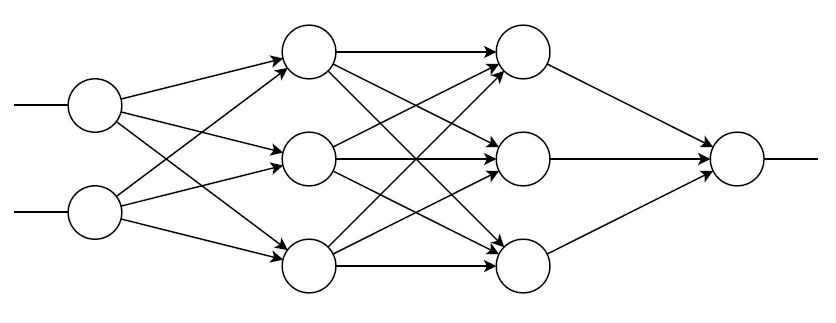
A perceptron is composed of a linear function, and an activation function.
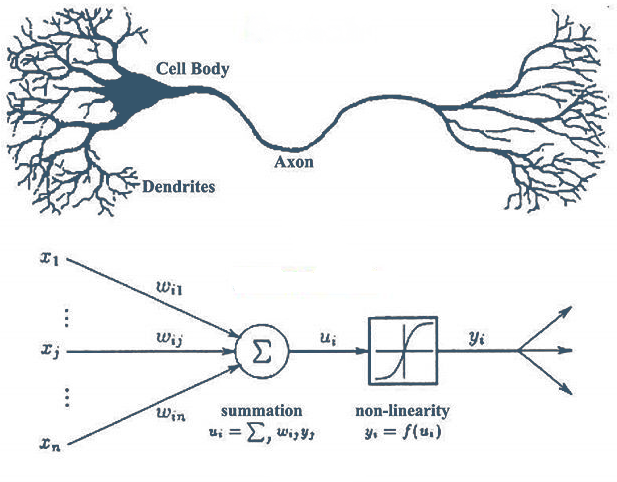
Mathematically the perceptron would look like this:
- y = f(wx + b)

- "
x" is the data or signal it receives from another neuron - "
w" is the weight that the signal received will have. - "
b" is the bias of the neuron that corrects the prediction, in a linear equation "y" = "b" when all "x" is equal to 0.
In our implementation we will calculate the predictions in this way. - "
f()", is the activation function, then we explain about this
The variables "w" and "b" control the result of the output "y". See this example
where:
- "X,W,B" are matrix
- "m" is the input examples number
- "i" is the inputs number
- "n" is the outputs number
Layer
Open your code editor, create the file "neural_network.py" and write this.
class Layer:
def __init__(self, neurons):
self.neurons:int = neurons # the layer neurons
self.shape:tuple = None # input shape
self.W = None # the wight matrix, shape (inputs, neurons)
self.B = None # the bias matrix, shape (1, neurons)
def forward(self, X): # output shape (input_examples, neurons)
if self.shape is None:
self.init_layer(X)
return np.matmul(X, self.W) + self.B # matrix multiplication
def init_layer(self, X):
self.shape = (X.shape[-1], self.neurons) # X.shape (input_examples, input_data_size)
# create initial parameters
self.W = np.random.rand(*self.shape) * 2 - 1
self.B = np.random.rand(1, self.neurons) * 2 - 1
def __call__(self, X, training=False):
Y = self.forward(X)
if training: # if the model is training
self.X = X
self.Y = Y
return Y
This is the implementation of a layer, a layer is a set of neurons receiving the same inputs
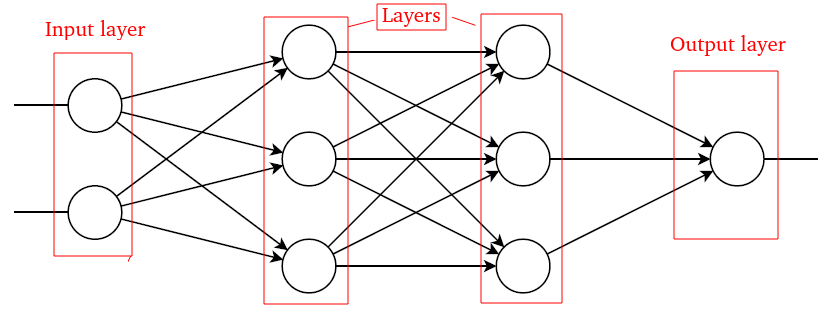
But, this is layers of linear functions, only it can do linear regressions.
For make a neural network, the layers need activation functions. we will implement it.
Activation function
First we implement the activation functions, this are the sigmoid activation and tanh activation
Sigmoid:
Tanh:
ReLU:
We implement it:
# a dict for select a activation function
activations = {
'sigmoid': {
'function': lambda X: 1 / (1 + np.e**(-X)),
'derivative': lambda X: np.e**(-X) / ((1 + np.e**(-X))**2)
},
'tanh': {
'function': lambda X: np.tanh(X),
'derivative': lambda X: 1 - np.tanh(X) ** 2
},
'relu': {
'function': lambda X: ((X / (X.max() + 1)) * (X > 0)),
'derivative': lambda X: 1 * (X >= 0)
}
}
Now, the Layer with activation function.
class Dense(Layer): # this inherits from the Layer class
def __init__(self, neurons, activation='sigmoid'): # sigmoid activations for default
super().__init__(neurons) # init the layer
self.activation:dict = activations[activation] # get specific activations functions
def forward(self, X):
Y = super().forward(X)
return self.activation['function'](Y) # calculate with activations function
Neural Network Model
Finally, the neural network.
class Model:
def __init__(self, layers:list=[]):
self.layers:list = layers
def add(self, layer: Layer):# add a Layer
self.layers.append(layer)
def forward(self, X, training=False): # forward in all layers
Y = X
for layer in self.layers:
Y = layer(Y, training)
return Y
def __call__(self, X, training=False):
return self.forward(X, training)
Testing our model.
In other file "test_model.py" copy this:
import unittest
import numpy as np
from neural_network import Dense, Layer, Model
def testing_model_outputs(model: Model, condition):
examples: int = np.random.randint(512) + 1 # random number of examples between 1-512
inputs: int = np.random.randint(256) + 1 # random number of inputs between 1-256
X = np.random.rand(examples, inputs)
Y = model(X)
assertion = condition(X, Y)
return assertion
def add_many_layers_to_model(model: Model, layer:Layer):
layers = np.random.randint(10) + 1 # random number of layers between 1-10
for _ in range(layers):
neurons = np.random.randint(128) + 1
model.add(layer(neurons))
class TestNeuralNetwork(unittest.TestCase):
def test_model_without_layers(self):
"""
The model has no intermediate layers, the input and output must be the same
because the data was processed
"""
assert testing_model_outputs(
Model([]),
# input and output are the same, so their subtraction is 0
condition=lambda X, Y: np.mean(Y - X) == 0
)
def test_model_number_of_examples_constant(self):
"""
The input and the output are different but must have the same number of examples.
If the input is from (m, i) the output must be from (m, n)
"""
model = Model([])
add_many_layers_to_model(model, Layer) # let's pass the Layer class as an argument
assert testing_model_outputs(
model,
# X.shape[0] is the number of examples
condition=lambda X, Y: Y.shape[0] == (X.shape[0])
)
def test_model_output_shape(self):
"""
if you have an input with the form (m, i) and the last layer has "n" neurons,
the output must have the form (m, n)
"""
model = Model([])
add_many_layers_to_model(model, Layer) # let's pass the Layer class as an argument
last_layer_neurons = 3
model.add(Layer(last_layer_neurons))
assert testing_model_outputs(
model,
# X.shape[0] is the number of examples of the input
condition=lambda X, Y: Y.shape == (X.shape[0], last_layer_neurons)
)
if __name__ == "__main__":
unittest.main()
Don't panic!, this is just a test to see if the model works.
In this file 3 tests are carried out:
test_model_without_layers: the model has no layers, the input is not rendered, so the model returns the input as output.
test_model_number_of_examples_constant: the models have a random number of layers, but the number of examples must be the same, for example, if it receives 4 mathematical exercises it will deliver 4 mathematical exercises
test_model_output_shape: in the previous test we saw that the number of examples is constant, but each example must have the same number of outputs as the number of neurons in the last layer.
run:
python test_neural_network.py
output:
...
----------------------------------------------------------------------
Ran 3 tests in 0.009s
OK
This means it works. As an exercise you can add a method to the TestNeuralNetwork class and create a model with Dense layers, the model must return random values between 0-1
You can also initialize the Dense layers with a second argument "tanh" if the last layer has this parameter it will return values between -1 to 1
Training the model
We have the neural network implemented, now we need to train it.
Calculation of losses
We create a new file in the same folder "training_model.py" and we start typing this:
import time
import numpy as np
# we import our model
from neural_network import Model
def mse(Y, target):
return np.mean((target - Y) ** 2, axis=1)
def d_mse(Y, target):
return (2 * (Y - target)) / Y.shape[1]
"mse" mean square error, the error calculation model
- "m", is the output examples number.
- "t", targets
- "y", output prediction for the model
Calculation of gradients
Now type this in the same file:
def train_step(model: Model, X: np.ndarray, target: np.ndarray, lr: float):
Y = model(X, training=True) # model prediction
acc = np.int64(target.argmax(axis=1) == Y.argmax(axis=1)).mean() # accuracy
loss: np.ndarray = mse(Y, target) # prediction loss
gradients = [] # gradients
for layer in reversed(model.layers): # Back-propagation
derivative = layer.activation['derivative'] # activation derivative
if layer == model.layers[-1]:
fault: np.ndarray = d_mse(Y, target)
# calculating the fault of the neuron
fault = fault * derivative(layer.Y)
# Gradient calculation
gradient: np.ndarray = np.matmul(fault.T, layer.X).T
b_gradient: np.ndarray = np.matmul(
fault.T, np.ones((X.shape[0], 1))).T
gradients.append((gradient, b_gradient)) # save to gradients
# update fault for back layer
fault: np.ndarray = np.matmul(fault, layer.W.T)
for layer, gradient in zip(reversed(model.layers), gradients):
gradient, b_gradient = gradient
layer.W = layer.W - lr * gradient # Update weights
layer.B = layer.B - lr * b_gradient # Update bias
return loss.mean(), acc
Important functions and variables:
gradient, is a vector that indicates where the new value of the weights "W" should move tob_gradient, gradients for the bias "B"update_parameters, this functions update the "W" and "Busing the gradients"lrlearning rate, is the step size that the weights "W" travel to approach the point of least loss
Gradient calculations are very complex. It is calculated in this way.
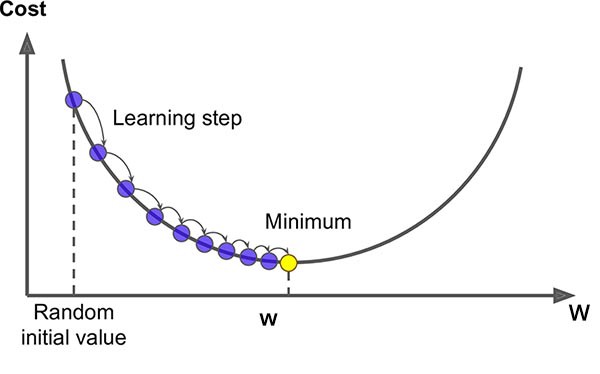
Training cycles
Type this code:
def fit(model: Model, X: np.ndarray, targets: np.ndarray,
batch_size: int, epochs: int, learning_rate: float = 0.0001):
# X and targets must have the same number of examples
assert X.shape[0] == targets.shape[0]
for epoch in range(epochs):
last_examples = len(X) % batch_size
# batching the inputs
x = list(X[last_examples:].reshape(
len(X) // batch_size, -1, X.shape[-1]))
if X[:last_examples].size > 0:
x.append(X[:last_examples])
# batching the targets
target = list(targets[last_examples:].reshape(
len(X) // batch_size, -1, targets.shape[-1]))
target.append(targets[:last_examples])
# metrics variables
error = None
accuracy = None
start = time.time()
# epoch iteration
print(f'Epoch: {epoch+1}:')
for i, inp, tar in zip(range(len(x)), x, target):
loss, acc = train_step(model, inp, tar, learning_rate)
# metrics calculation
if error is None and accuracy is None:
error = loss
accuracy = acc
else:
error = (error + loss) / 2
accuracy = (accuracy + acc) / 2
# printing metrics
msg = f'batchs: {i+1}/{len(x)}, Error: {error} Acc: {acc}'
print("", end='\r')
print(msg, end='')
print("", end='\r')
print(msg + f' Time: {time.time() - start}')
Here we have the function "fit ", here we define the training cycles that our model will have, and some parameters to adjust.
Xis a matrix with the shape (m,i) contains the examples for the training of the model.targetsare the expected outputs with the shape (m, n), "n" is the number of the outputs.batch_sizeis the size of the batch in which the examples are grouped, the data can be grouped in small batches to reduce the computational cost of training and help the model to generalize the information, if its value is1it will be trained the model sequentially.epochsis the number of times the model will cycle through all the exampleslearning_rateis already explaining
Testing our model with real data
Now we are going to use a jupyter notebook, if you aren't using vscode, you can code in a script.py
we create a file "test_model.ipynb" if you are using vscode or "test_model.py" if you use another code editor.
first we import what we need
We Install tensorflow to use a dataset and matplotlib to visualize the data.
pip install tensorflow matplotlib
# libraries
import numpy as np
from matplotlib import pyplot as plt
# Our code
from neural_network import Model, Dense
from training_model import fit, d_mse
# mnist dataset from tensorflow
from tensorflow.keras.datsets import mnist
Now we load the dataset
# Load dataset
(x_train, y_train), (x_test, y_test) = mnist.load_data()
Viewing the dataset.
plt.figure(figsize=(15, 8))
for i, img, label in zip(range(10), x_train[:10], y_train[:10]):
plt.subplot(2, 5, i + 1)
plt.imshow(img)
plt.xlabel(label)
plt.show()
If you managed to run the code until this point you should be able to view images of handwritten numbers.
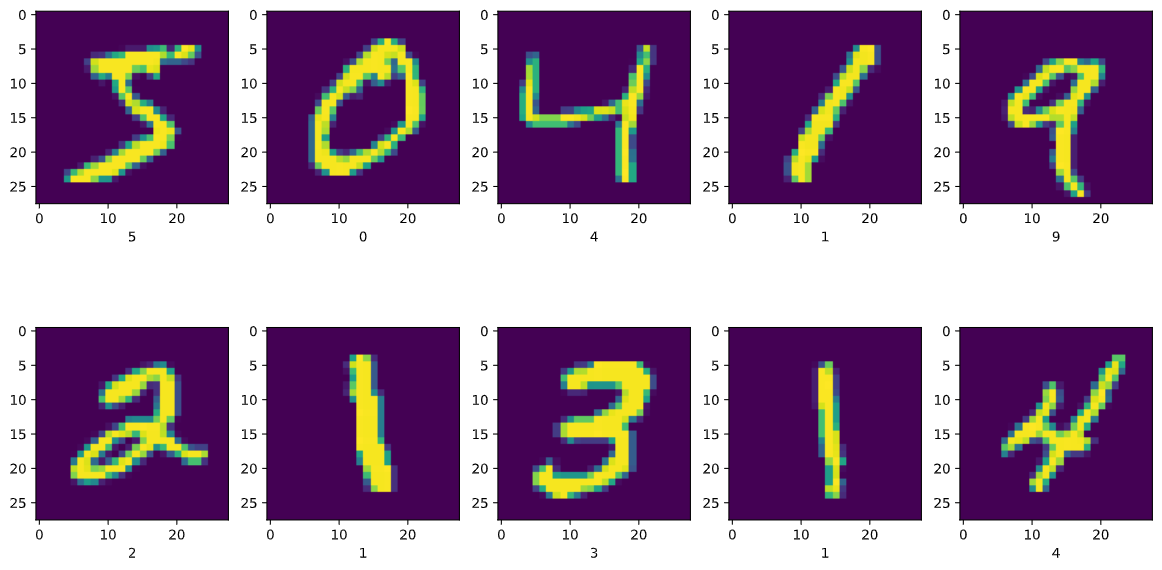
Now we transform the data so that the model can process it.
x_train = x_train.reshape(len(x_train), -1) # shape (60000, 28*28)
x_train = x_train / 255 # normalizing data to values between 0-1
zeros = np.zeros(
shape=(y_train.size, int(y_train.max() + 1)) # zeros matrix shape (m, i)
)
zeros[np.arange(len(y_train)), y_train] = 1 # one hot encodig
y_train = zeros # shape (60000, 10)
x_test = x_test.reshape(len(x_test), -1) # shape (10000, 28*28)
x_test = x_test / 255 # normalizing data to values between 0-1
zeros = np.zeros(
shape=(y_test.size, int(y_test.max()) + 1) # zeros matrix shape (m, i)
)
zeros[np.arange(len(y_test)), y_test] = 1 # one hot encodig
y_test = zeros # shape (10000, 10)
We create the model:
model = Model([])
model.add(Dense(128, activation='relu'))
model.add(Dense(10, activation='sigmoid')) # output layer
The model has 2 layers, the hidden layer that has 128 neurons with the relu function and the output layer that has 10 neurons with the sigmoid function, the output layer will tell us what number it sees in each image.
Note that the number of neurons in the last layer is equal to the number of numerical characters that we have available in the dataset [0 1 2 3 4 5 6 7 8 9].
Now to train the model°
fit(model, x_train, y_train, batch_size=256, epochs=5, learning_rate=0.01)
Console output:

I explain:
x_trainis the input data for the model.y_trainis the target, the expected output.batch_sizethe model loops through the dataset in batches of 256 samples.epoch5 laps.learning_rate0.01, The step size of the weights is small enough to avoid sudden changes in training.
Apparently the model predicts with an acc = 0.9, that is, an accuracy of 90%. We will see if this is true using the test data.
Type this in the file:
predictions = model(x_test)
ACC = np.int64(y_test.argmax(axis=1) == predictions.argmax(axis=1)).mean()
print (f'accuracy: {ACC}')
If the console output looks like this accuracy: 0.9063, the model was training correctly.
Try it with other values in the parameters of the fit function to see what results you can get. You can also try increasing more layers to the model with the number of neurons you want, the possible values for the "activation" parameter are the strings: "sigmoid ","tanh" and "relu".
Now we are going to visualize the test results with the test data
In the same file write:
def plot_image(i, predictions_array, true_label, img):
predictions_array, true_label, img = predictions_array, true_label[i], img[i]
plt.grid(False)
plt.xticks([])
plt.yticks([])
plt.imshow(img, cmap=plt.cm.binary)
predicted_label = np.argmax(predictions_array)
true_label = np.argmax(true_label)
if predicted_label == true_label:
color = 'blue'
else:
color = 'red'
plt.xlabel("{} {:2.0f}% ({})".format(predicted_label,
100*np.max(predictions_array),
true_label),
color=color)
def plot_value_array(i, predictions_array, true_label):
predictions_array, true_label = predictions_array, true_label[i]
plt.grid(False)
plt.xticks(range(10))
plt.yticks([])
thisplot = plt.bar(range(10), predictions_array, color="#777777")
plt.ylim([0, 1])
predicted_label = np.argmax(predictions_array)
true_label = np.argmax(true_label)
thisplot[predicted_label].set_color('red')
thisplot[true_label].set_color('blue')
And:
num_rows = 5
num_cols = 3
num_images = num_rows*num_cols
plt.figure(figsize=(2*2*num_cols, 2*num_rows))
for i in range(num_images):
plt.subplot(num_rows, 2*num_cols, 2*i+1)
plot_image(i, predictions[i], y_test, x_test.reshape(-1,28,28))
plt.subplot(num_rows, 2*num_cols, 2*i+2)
plot_value_array(i, predictions[i], y_test)
plt.tight_layout()
plt.show()
You should see a result like this.
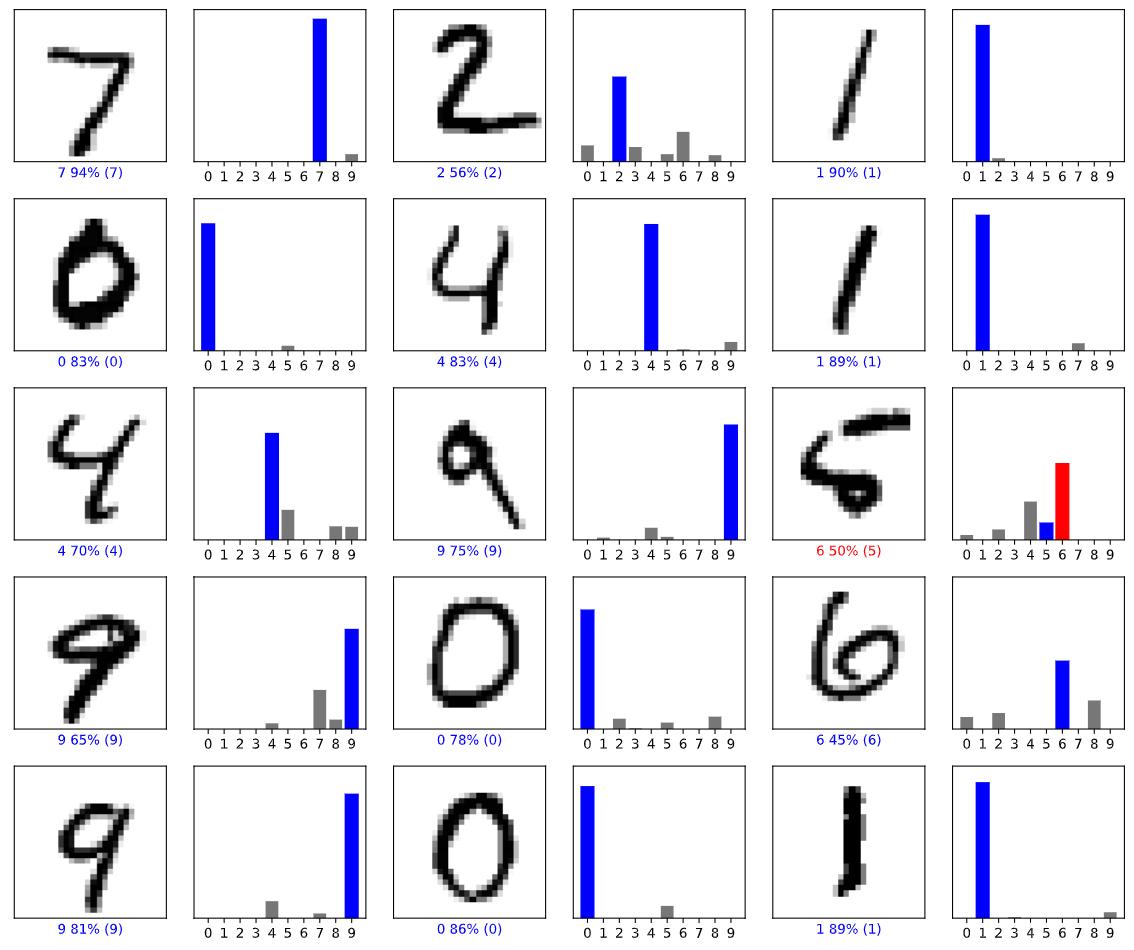
That's it, I hope you have learned something from this blog.
Bye.


Comentarios: